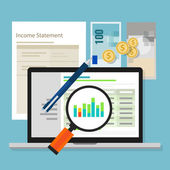Blog
Your balance sheet (now more correctly called a Statement of Financial Position) reveals a great deal about your business, including the total value of your assets – the things you own; how much you owe to others – your liabilities; and the level of your solvency.
These three aspects will be studied carefully by lenders and investors − and by buyers if you intend to sell your business. But they should also be important to you, because it’s important to be solvent at all times. In other words, you need to have more assets than liabilities available to pay your debts.
If you can’t pay bills when they fall due, your business may be technically insolvent. Fortunately two simple tests can quickly reveal your solvency.
- The Current Ratio test
This test simply involves dividing your assets by your liabilities (you should find both figures on the balance sheet). For example, if a business has assets of $435,000 and liabilities of $180,000, the current ratio is 435,000 divided by 180,000 = 2.42.
In other words, the business has $2.42 in assets for every $1 of debt. On the face of it, the business is solvent, as the minimum ratio most banks would regard as acceptable is $2 for every $1 of debt.
But wait a minute. Your assets include stock (your inventory). What’s your stock really worth? If you had to sell it all tomorrow to pay off your debts, could you really get out the full amount shown on the balance sheet?
- The Quick Ratio test
Let’s try a tougher test – this time leaving out your stock. The aim here is to find out if your business has enough quick money (ready cash) to pay your bills if your creditors demanded repayment tomorrow. Let’s say the business has $325,000 in stock. Subtract this from the assets figure of $435,000 and the assets reduce to $110,000.
Now for the Quick Ratio: $110,000 divided by $180,000 = 0.61.
Hmm − the picture is no longer so rosy. The business has only 61 cents in ready cash for every dollar of debt, meaning it could not immediately pay its debts.
Your aim should be to have at least $1 in assets available in quick cash for every $1 of debt, a ratio of 1:1. You’ll sleep better, and so will your bank manager.
Strengthening your balance sheet
A positive step to strengthen your balance sheet is to take a closer look at the quality of your inventory. If you had to sell all your stock in the next week or month to pay your debts, would you get the full amount shown on the balance sheet? In many businesses, the answer would be no.
If you know you have obsolete or slow-moving inventory sitting on your shelves, talk to us about ways to get rid of it. We can discuss ways to reduce or get rid of obsolete stock, such as:
- Holding a sale.
- Bundling unwanted stock with more popular items as a ‘special offer’.
- Choosing the most advantageous time of year to write it off if necessary.
We can also show you how to measure the stock turn rate in your business to improve stock management and profitability. In broad terms, the faster you turn over your stock, the more efficient your business. A fast turnover rate can also reflect more efficient inventory management.
Closing tips
- Many business people find a balance sheet more difficult to read than a profit and loss account. If this applies to you, we can help you understand it better so you can gain more from the figures.
- Getting a balance sheet just once a year is certainly not enough! A balance sheet offers important insights into your business. With the right accounting software you can generate a balance sheet whenever you need one.


Quick and efficient payment options benefit both small business owners and their customers.
Consumers are used to flexibility – cash, check or charge? – when buying from large retailers. If you’re a cash-or-check only operation, consider how many sales you may be losing – and how your business would grow if your customers could pay with debit or credit cards.
If one of your goals is to start selling online, an easy-to-use payment processing system is a must.
Read on to learn the most important features when searching for the right payment management system for your small business.
1. Cost considerations
Cash flow is typically one of the biggest concerns reported by small business owners – so ROI is key when investing in any new system. Some companies like FreshBooks are tailored for small businesses in the service industries and offer a flat rate fee of 2.9%. Paypal offers flexible payment options at low rates and was designed with small businesses and start ups in mind.
If you use online accounting software, start by looking into whether an affordable payment add-on is available. This option may make the most sense as you’ll greatly increase efficiency when payment processing, invoicing, customer data and financial reporting are part of an integrated all-in-one system.
2. Mobile compatibility
Forget card reader machines. A payment processing system that syncs up with your tablet or smartphone is a great fit for small business owners – especially when selling on the go. Just think how mobile payment processing will make your life easier when you’re making sales at trade shows or when travelling for business.
3. Security concerns
When you’re accessing your customer’s credit card data, you want to know with 100% certainty their financial information is kept safe and secure. Inquire into how any payment solution option you’re considering protects sensitive client data. Some payment processing solutions like CyberSource use tokenization to let you accept credit card payments without storing data in your system.
4. Try it for free
Many companies who market payment processing systems to small business owners offer a free 30-day trial. Why not research a handful of the best solutions available and give them a test drive before deciding on the right option for you?
Now that you’ve looked into the benefits of a payment processing system – and what to look for before you make the leap– it’s time to take action.
Start by shortlisting a few of the best contenders. Ask your colleagues for input on the payment processing system they use. Read online reviews to get some unbiased opinions. And take the time to investigate whether an add-on is available for your online accounting software – or which third-party payment processing apps integrate with your current accounting system.


f you think accounting software is just for tracking expenses and generating financial reports, you’re losing out on an opportunity to improve your bottom line. By taking advantage of insights provided by your software solution, you’ll benefit from a more informed approach to marketing and customer service – and by making the most of all the ways your software can improve productivity you can take meaningful action to increase profits. Here’s how. Understand buyer behavior
In addition to storing real time financial data, your accounting software can also retain important information about your clients. Insights into your customer buying history and preferred payment methods, for instance, can help you tailor your marketing strategies to each type of client you serve. Use what you know about customers to set up a segmented mailing list. Marketing directly to the clients who tend to hire you for a particular service is a much more effective way to make sales than approaching your customers with a one-size-fits-all email campaign or in-store promotion.
Reporting capabilities built in to your accounting software can show you who your best customers are and your most popular products. With this key info, you’ll hit your sales targets by only promoting the goods and services that you know your customers really want. The real time data your accounting software provides can also translate to an improved overall experience that will win over your customers. For instance, when a client gets in touch with a question you’ll be able to respond quickly with useful, accurate background info. With more in-depth knowledge of your customers you’ll be able to cross sell and upsell more easily by suggesting additional products that might meet their needs.
Free up time to reach more customers
One of the great things about accounting software is how much time you’ll save by automating processes like invoicing and payroll. And if your software solution integrates with your other small business apps as well as your CRM, ERP or POS systems, your business will be even more productive. By getting more efficient, you’ll have more time to touch base with customers and find new clients.
Consider making the most of that extra time in your schedule to
- organize professional development opportunities that improve your team’s sales skills
- update your business plan based on real time financial data and enhanced reporting
- determine the best on and offline marketing strategies for your business based on what you know about your customers’ spending patterns
- implement loyalty rewards for your return customers that you know will appeal to them – a sure fire way to spread positive word of mouth
- implement growth strategies designed to scale your business and
- make more informed decisions on every aspect of your business to cut costs, improve productivity and boost your profit margin.
How will you boost your bottom line?
Now that you’re fully aware of the customer insights and time-saving capabilities your accounting software provides, what will you do differently to build a more profitable and successful business?

Many small business owners think they’re saving money by handling their financials themselves. While it’s a real asset to learn bookkeeping basics, cash flow management and your tax obligations, hiring an accountant to oversee your finances has many benefits. Leaving your books to a pro will free up time so you can focus on serving your clients and implementing plans for growth. Here are a few ways an accounting professional can help you save money that you can reinvest back in your business.
Finding money
There’s no one more suited to discovering “found” money than an accounting professional. Hire an accountant to sort your books and systemize your bookkeeping; better record keeping is the easiest way to allow you to quickly see – on a monthly, weekly or daily basis – where your money is going so you can cut costs. Keeping your accounts up to date will also help you understand which of your business investments yield the greatest returns so you can be more strategic about spending. An accountant can spot trends that you can take advantage of to earn greater profits – and even find savings with vendors, staff and operating expenses. Hiring someone to manage your accounts will also reduce the costly errors that are commonplace when business owners try to manually track their expenses.
Avoid tax penalties
Your accountant may be your trusted advisor when it comes to staying up to date with the latest regulations for small business taxes. She can also provide you with expert advice on how to maximize your benefits and minimize your taxes each year. Don’t underestimate the cost savings of hiring someone to complete your tax forms correctly and submit them on time. Penalties for small businesses who neglect to file their taxes on time – or at all – can quickly add up; the longer you wait to file, the more interest you’ll be charged and the likelihood you’ll incur additional penalties. A business that is already struggling may not be able to pay a tax fine and find themselves closing their doors. If your small business is ever audited, having an accountant on board will let you rest easy knowing you won’t be hit with a penalty for errors or omissions.
Business advisory services
Your accountant possesses business knowledge that can help you make more informed decisions. Rely on your accountant for advice when you draft or revise your business plan; those key insights on assessing profitability will help you move your business in the right direction – and avoid wasting time and money on strategies with a lesser chance of success. Look to your accountant to help you determine your most valuable clients, how much money you need to invest in a growth plan and which marketing strategies yield the best ROI. Having someone you can rely on to help set targets and monitor your progress is an invaluable asset that can help you not only save money, but earn higher profits.
The bottom line? Your accountant can do much more for you than simple bookkeeping or ensuring you’re on the right side of the tax authorities. Hire a small business accountant and you’ll be doing a lot to help increase your chances for long term growth and success.


Many small business owners assume that cyber attacks only happen to big companies, banks or governments. But the truth is, limited knowledge of digital security and lack of defences make small businesses particularly vulnerable to attack.
Research shows that 71% of all cyber attacks happen to businesses with less than 100 employees – and yet many CEOs have yet to invest in a formal defense plan.
With cyber attack insurance premiums running as high as $35,000 per year, prevention is typically the smartest (and most budget-friendly) approach for small business owners.
Follow these four steps to fortify your small business against a cyber attack, and maintain the ongoing trust of your valued customers.
Conduct a Cyber Threat Assessment
75% of small business owners simply don’t know if they have enough cyber security – or the right solutions – to protect their digital assets.
A thorough threat assessment is the ideal first step to knowing precisely where and how your small business may be vulnerable to cyber intruders.
Consider contracting a cyber security specialist to help you analyze your digital ecosystem and data storage practices, in order to identify weak areas and create a security action plan.
Install a Firewall and Anti-virus Software
Cyber attackers use highly sophisticated automated software to seek out and infiltrate poorly defended networks.
Ensure your business doesn’t get caught in their net by installing a firewall that can control incoming and outgoing data and help prevent unauthorized access to your network.
Other practical steps you can take to protect yourself include:
- ensuring your anti-virus software is always up to date
- updating your browser and applications like Java and Flash to the latest version
- protecting your WiFi by making it invisible to outsiders, encrypted and secure.
Regularly Change Your Passwords
Many businesses overlook the importance of regularly changing passwords that guard critical systems and confidential data.
Refresh your passwords every two months, ensuring they are at least 8 characters long and a mix of letters, numbers and symbols. Steer clear of using personal information, like your child’s name or your date of birth, as these combinations are much easier for cyber attackers to guess.
Invest in Employee Training
Employee education is one of the most important defenses against cyber attack. For lack of training, your own team members might inadvertently install malware or release confidential information to a criminal masquerading as a trusted contact.
A staggering 95% of online security breaches involve human error. Ensure your staff understand best practices in digital defense by:
- developing an easy-to-read cyber security guide so employees are better equipped to identify and deal with malware, dangerous email attachments, phishing attempts and other digital threats
- meeting regularly to discuss new potential online threats so team members know what to watch for
- encouraging each team member to speak up immediately if they notice suspicious behavior on your digital network.
By implementing these preventative measures, your company will be well positioned to evade cyber attack – and get on with the business of growing!


Most small business owners who use accounting software quickly master the basics. They automate processes like invoicing and payroll, track expenses and view real time financial reports to manage cash flow and make better business decisions.
But what many business owners don’t take advantage of are key insights that can improve customer care and increase sales. Here are some smart ways you can use your accounting software to help boost your bottom line.
Gain insights that increase sales
If you’re not tapping into your accounting software analytics to better understand your customers, you’re missing a major opportunity to close more sales.
Most accounting software can highlight your biggest spenders and buying trends. How would knowing who your best customers are, your biggest selling products and how much each customer spends impact your marketing decisions – not to mention help you fine tune your sales strategies?
By the same token, when you know which products and services aren’t selling, you’ll be able to make more profitable purchasing decisions. Most accounting software offers inventory tracking to help you decide what to keep on the shelves, which products to sell off at a discount and which items to phase out altogether.
Improve customer care and boost profits
Accounting software can offer peace of mind when you know your financials are accurate and up to date. But another major advantage of an online accounting solution is how much time you’ll save by automating processes like invoicing and payroll – giving you more time to follow up with clients and seek out new prospects.
We all know how important the personal touch is when it comes to sales. So why not use your accounting software customer data to help remember your customers’ birthdays or thank them when they’ve hit a milestone – spending more than $5,000 on your products, for example?
With enhanced customer data at your fingertips, your business will earn a reputation for personalized service. You’ll be able to respond quickly when a customer calls with a question about a product or an order. And you’ll be able to suggest substitutions and offer valuable add-ons based on their buying preferences, so upselling becomes a snap.
How will you use accounting software to grow your small business?
Savvy business owners take the first step toward better profitability when they stop thinking of accounting software as simply a financial management solution and start thinking of it as a comprehensive tool for business growth.
You may be surprised at the many ways accounting software can help you better serve your customers or improve your sales strategies when you look at its true potential.
Now that you have a handful of ideas for making better use of your accounting software, what will you do differently to enhance customer care, improve your profits and continue to grow your business?


When your email list is small or you’d just like to add more people and get higher open rates, it’s smart to grow your list through personal contacts. Begin with the obvious: ask friends, family and business contacts to sign up. Everyone has a pool of people who might be happy to hear about your business via email. All you have to do is remember to ask. Put a note by your phone or computer with a couple of sentences so you don’t have to think about asking each time. After you’ve worked through your personal and business contacts, it’s time to get creative.

It’s the little things that make up the big things. Here’s a list of ten traits of some of the movers and shakers in the world today (and from the past).



Whether you’re an entrepreneur seeking lucrative new partnerships or a skilled worker in search of the perfect job placement, LinkedIn is the social network you need to be using. As the world’s premier social network geared towards professionals from all walks of life, LinkedIn is effectively your online portfolio and résumé. Companies all over the world use it daily to seek out valuable new connections, but with some 350 million accounts on the network, it is important that you do everything you can to make your own profile stand out.

The words ‘personal brand’ are still somewhat controversial, and carry an unfortunate cast of self-promotion and vanity. The truth is that personal branding is more important than ever in the job market, and those without a clear personal brand or mission to create one are lagging behind the competition.

Being an entrepreneur is often about getting the most value out of your resources. That means spending only on the necessities, and nothing more. Unfortunately, things you consider to be a waste of your capital may actually be what your start-up needs to survive. Some of them are expensive, especially for a new company, but they’re worthwhile.

